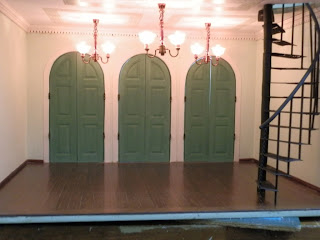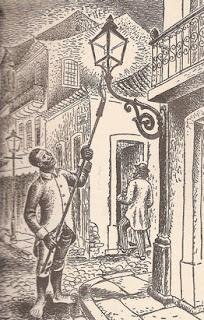Most roofs I've seen in dollhouses are American or British style, meaning thatched, slates or shingles . Sometimes, not very often, we get to see a Mediterranean one too (clay or ceramic tiles) - the round kind only...
Na época colonial, não era permitido ter fábricas no Brazil. Pouquíssimos produtos podiam ser fabricados aqui. Telhas eram feitas para uso próprio das propriedades, pelos escravos, que moldavam as telhas nas suas coxas. Até hoje usamos a expressão "feito nas coxas" para dizer que algo foi mal-feito, sem cuidado, sem profissionalismo... :) Enfim, esta telha colonial é a que mais se parece com o estilo mediterrâneo.
In the colonial times, there were no factories in Brazil at all. Very few things were allowed to be made here. Roof tiles were made for personal use on site only (no commercial use), and were made by slaves, who would mold the clay on their thighs. To this day we use the expression "made on thighs" when we mean that something was made carelessly... :) Anyhow, this is the kind that looks more like the Mediterranean kind.
 |
| telha colonial colonial roof tiles |
Nowadays there are several different kinds of ceramic roof tiles in use here. I wanted to use a style more frequently found in Brazil. Namely, using a kind of ceramic tile called "French" or Marseillaise. By the second half of the 19th century, this model - which was imported from France, hence the name it got here - became more and more popular. Less units are needed to cover the same area, so it's more economical. But it needs more wood work beneath, so it lost popularity from the second half of the 20th century on, as wood became more expensive. Due to this fact, nowadays the most popular models are the "Roman", the "American" and the new "Portuguese" kinds.
 |
| Diferentes tipos de telhas Different kinds of ceramic tiles |
 |
| O modelo que eu queria usar - a telha francesa The kind I wanted to use, the French roof tile |
 |
| Um telhado bem antigo, de telha francesa A very old roof, with French roof tiles |
But... I could not find any "French" roof tiles in miniature. Back in 2008, while still planning the store, I found the "Roman" kind. So I bought 300 of them! And some transparent resin ones too.
Em vez de simplesmente colar as telhas sobre um telhado de madeira interiço, como geralmente é feito nas dollhouses, vou fazer o madeiramento por baixo, como é feito aqui tradicionalmente em tamanho real. (veja um vídeo que achei sobre como um telhado real é instalado)
I am going to make the roof the traditional way, with some beams & rafters, instead of just gluing the tiles on a plank of wood, as it's usually done on dollhouses. (watch a video on Youtube I found on how a life size roof is installed)Um outro produto que não se fabricava aqui enquanto éramos colônia era vidro. E transportar placas de vidro pelas grandes distâncias necessárias à importação, e por lombo de burro até o interior, era muito arriscado - vidro é frágil e quebra-se fácil, como você já sabe... Então a maioria das casas não tinha janelas com painéis de vidro. Em vez disso, tinham rótulas. Quando a família real portuguesa chegou em 1808, as autoridades locais tentaram mudar este hábito por força da lei, obrigando a substituir por vidro. O uso das rótulas era considerado um costume bárbaro. Mas não adiantou, a 'moda' não pegou! Pelo mesmo problema de logística já explicado... :)
Another thing that was not allowed to manufacture here while we were a colony was glass. And transport them over the huge distances needed to import was too risky - glass is fragile and breaks easily, as you know... So most houses did not have glass paneled windows. Instead, they'd have lattice panels. When the Royal family arrived, in 1808, local authorities tried to force by law to replace those with glass. They considered them "barbaric". Nope, that law didn't catch on! Due to the same logistics problem already explained.. :)
Mas, lá pelo final do século 19, a elite pirou nas coisas européias. As mansões, lojas, e edifícios chiques todos eram construídos com produtos importados da europa: tecidos, lustres, mármores e especialmente vitrais e espelhos. Grandes vidraças tornaram-se cada vez mais "populares". Até que seria divertido fazer uma clarabóia linda assim:
But, by the end of the 19th century, the elite was going bananas over European things. The elegant houses, stores, and buildings all had items imported from Europe: banisters, marble and, specially stained glass. Large windows became more and more "popular". It would be fun to make a skylight like this:
Porém não tem espaço para janelas na minha estrutura! A fachada tem portas (e não consegui colocar janelas lá...) Os fundos são abertos para permitir ver o interior. E precisarei das laterais para colocar estantes. Então decidi inserir o novo vidro "popular" no telhado! É isso mesmo, usando telhas "de vidro".
But there is no place for windows in my structure! The front has doors (and I couldn't use them there...). The back is open to allow us to see the interior. And I need the side walls to place shelves. So, I decide to insert the new popular glass on the roof! Yep, by using "glass" tiles.
Apesar delas não serem exatamente comuns então, telhas de vidro são, de fato, muito antigas. Eram usadas sozinhas ou combinadas com telhas comuns. Seu uso permite entrar a luz solar nos ambientes durante o dia. Têm um efeito higienizante, já que os raios solares evitam pestes como morcegos, ratos e insetos, que normalmente se abrigam sob a sombra e o frescor criados pelos telhados de cerâmica. E também evitam umidade e, portanto, mofo e bolor. Lembrando que rarissimamente o espaço entre o telhado e o teto era usado realmente, como são os sótãos na Europa e Estados Unidos. Geralmente aqui são espaços perdidos...
Though those weren't exactly common back then, glass roof tiles are indeed very old. They were used alone or combined with the regular ceramic tiles. Its use allows to cast some light into the rooms during the day. This has a sanitizing effect, as sun rays avoid pests like bats, rats and insects, that usually find shelter in dark and cool shadows under the roofs. It also prevents moist and therefore mold and mildew. Very seldom is the space under the roof and the ceilings used as attics here... Most part of the time, they are wasted spaces...
 |
| Obrigada! Thank you! |















































